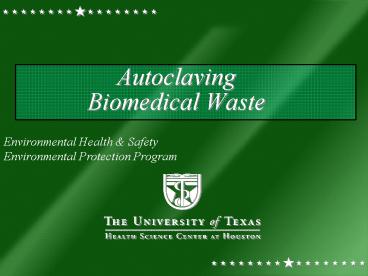Autoclaving Biomedical Waste - PowerPoint PPT Presentation
1 / 15
Title:
Autoclaving Biomedical Waste
Description:
An economical process of killing pathogenic microorganisms through saturation ... waste and keep the bags open or loosely taped (steam can't penetrate the bags) ... – PowerPoint PPT presentation
Number of Views:131
Avg rating:3.0/5.0
Title: Autoclaving Biomedical Waste
1
Autoclaving Biomedical Waste
Environmental Health SafetyEnvironmental
Protection Program
2
Why Autoclave?
- An economical process of killing pathogenic
microorganisms through saturation with moist heat
(steam) under pressure - This process makes the microorganisms nonviable
by destroying (denaturing) essential proteins and
structures
3
Waste Handling
- Biohazardous waste Materials
- Must be disposed of in a properly labeled heat
resistant autoclavable bag (usually red or
orange) - Add 1cup of water to each bag of solid waste and
keep the bags open or loosely taped (steam cant
penetrate the bags)
4
Waste Handling Continued
- Bags should be left to cool for several minutes
before removing from autoclave - Once cool, securely close biohazard bag and place
into opaque black bag which has large white trash
bin as secondary containment
5
Autoclave Use Log
6
Quality Control
- Methods for Quality Control
- Autoclave temperature tape (only tells desired
temperature reached not time or pressure) - Parameter monitoring (pressure, time and
temperature) - Record every load on autoclave use log
- Perform Efficacy monitoring
- 50 -100 lbs/month - monthly
- 100 -200 lbs/month - biweekly
- gt200 lbs/month weekly
- Routine parameter monitoring maybe substituted
for biological monitoring for autoclaves which
have a continuous readout and record of operating
parameters - (example autoclave with receipt tape style
printout)
7
Parameter Monitoring
- Parameter monitoring is necessary to ensure
efficacy of autoclave - Parameter can be performed by using Verify
integrator strips - Autoclaves that use pinwheel plots require
biological monitoring with Verify biological
monitoring vials containing live GeoBacillus
Stearothermophilus
Verify Self Contained Biological Indications
8
Autoclave Parameter Log
9
Autoclave Rooms are BSL-2 Rooms
- It is important to remember that all autoclave
rooms are BSL-2 (biosafety level 2) rooms - Indicates a biohazard is present such as
Hepatitis B virus, HIV, the salmonellae, and
Toxoplasma spp. Also includes human-derived
blood, body fluids, tissues, or primary human
cell lines where the presence of an infectious
agent may be unknown - Indicates that NO FOOD / DRINKS or cosmetics are
allowed in the room
10
Personal Protective Equipment
- When selecting PPE consider the highest level
hazard present, the source of the hazard, and the
potential for simultaneous exposures. - Face protection
- Goggles or safety glasses with side shields
- Clothing
- Lab coats, scrub suits, gowns (long pants only,
no open toed shoes) - Clothing should be replaced immediately when
contaminated - Gloves
- Verify gloves are compatible with your specific
application, process and materials before using - Gloves should be replaced immediately if torn
- Gloves should not be worn outside the lab area
- Always wear heat resistant gloves and keep your
face away from the door when loading and
unloading the autoclave
11
Employee Safety Practices
- Avoid compressing bags which may create aerosols
- Biological waste should be stored in rigid leak
proof containers such as biohazard boxes, bins,
or secondary containment pans - Waste should be stored inside the autoclave room
and not in the hallways - Biological waste containing hazardous chemicals
(flammables, chemotherapeutic agents) or Sharps
should not be autoclaved. Call EHS at
713-500-5837 for collection of these items - Biological Waste should not be left for someone
else to autoclave
12
Good Employee Work Practices
- Be a conscientious worker
- Keep work areas clean and free of hazards
- Use Standard Precautions
- Treat all human blood and body fluids as if known
to be infectious - No eating, drinking, or applying cosmetics in the
work area - Frequent hand washing
- Decontaminate work surfaces
- decontaminate surfaces daily
13
Common Biomedical Waste Autoclave Deficiencies
- EHS performs semiannual surveys of autoclaves
utilized for biomedical waste treatment - Common deficiencies include
- Food or drink consumed or stored in autoclave
area - Autoclave log incomplete
- Sterility monitoring not performed
- Training records incomplete
- Minors in the work place
14
In Summary
- Autoclave Use Guidelines to follow
- Place sterilizing indicator tape on the autoclave
bag. Make sure bags designated for autoclaving
are used - 2. Place waste inside autoclave. Use secondary
containment (pan) under the bag. If waste does
not contain any moisture, put ½ cup of water
inside bag for steam generation - 3. Autoclave according to manufacturers
instructions for a minimum 30 minutes, at a
minimum operating temperature and pressure of
250 deg. F and 15 psig - 4. When cycle is finished, inspect sterilizing
tape, and visually check bags to ensure
autoclave was working correctly - 5. Place waste in black opaque bags. Seal bag
with tape or tie wrap - 6. Place waste in trash cans labeled
Autoclaved Waste Only - Log activities in the autoclave usage log
- Perform routine efficacy monitoring and record
results
15
Any Questions?
- Please call EHS at 713-500-8100































